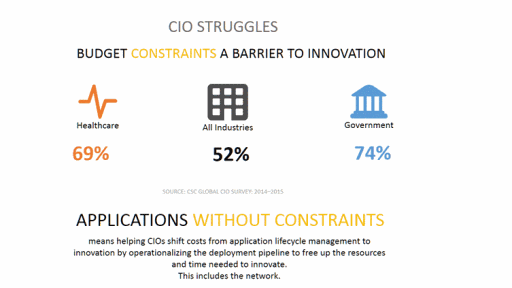Applications ohne Einschränkungen: Optimierung des IT-Budgets
Mit dem Jahresende ging die traditionelle Flut an Vorhersagen und Prognosen von Fachzeitschriften, Experten und Analysten einher. Dazu gehörten auch die zahlengeladenen Prognosen für die IT-Budgets im Jahr 2016.
Keines davon war besonders beeindruckend. Auch wenn Konsens darüber zu herrschen scheint, dass bei den IT-Budgets zumindest erste Anzeichen für Fortschritte (Aufwärtstrend) erkennbar sind, trifft dennoch zu, dass viele Budgetbeschränkungen als Hindernis betrachten.

Wir konnten diese Binsenweisheit selbst in der Praxis erleben: Kunden, die an unserer jüngsten Umfrage zum Stand der Application teilnahmen, angaben, dass zu kleine Sicherheitsbudgets (41 %) zu ihren fünf größten Sicherheitsherausforderungen gehörten. Auch mehr als die Hälfte der CIOs gaben in der jüngsten CSC-Umfrage an, dass Budgetbeschränkungen ein allgemeines Hindernis für Innovationen darstellten.
Diese Einschränkung muss natürlich aufgehoben werden, um die Schleusen für Innovationen zu öffnen und der IT dabei zu helfen, ihr Ziel zu erreichen, Geld für das Unternehmen zu erwirtschaften, statt es nur zu dessen Unterstützung zu verbrauchen.
Aber wie das alte Sprichwort sagt: Das ist leichter gesagt als getan.
Um dies zu erreichen, muss der CIO eine Umgebung schaffen (eine Kultur annehmen), in der Kernbereiche des Budgets wie Betrieb, Sicherheit und App-Bereitstellungen optimiert werden können. Durch eine derartige Optimierung können entweder die Kosten gesenkt werden, wodurch die Einsparungen auf innovationsorientierte (und damit gewinnbringende) Projekte verlagert werden können, oder es kann die Notwendigkeit einer Ausgabenerhöhung insgesamt verringert werden, sodass sich Budgeterhöhungen auf Innovationen konzentrieren können.
Dies bedeutet letztendlich, DevOps zu akzeptieren, was alle DevOps (hier IT-Silo einfügen) einschließt.
- Optimieren Sie den Betrieb
Einer der mit DevOps verbundenen Schlagworte lautet „Infrastruktur als Code“. Dies kann – nein, es sollte – die Netzwerkinfrastruktur umfassen, die durchschnittlich 10 App-Dienste bereitstellt, auf die sich 60 % der Unternehmen verlassen, um sicherzustellen, dass Apps schnell, sicher und verfügbar sind. Durch die Verfügbarkeit von APIs und Vorlagen können die Automatisierung und Verwaltung von App-Diensten ermöglicht werden, um die Kosten zu senken und die Stabilität zu verbessern, wodurch kostspielige Ausfallzeiten reduziert werden. Diese Einsparungen können in Innovationen umgewandelt werden. - Optimieren Sie die Sicherheit
Ein Hauptanliegen sowohl in der Cloud als auch vor Ort ist weiterhin die Sicherheit. Die Sicherheitsbudgets steigen zwar, sind aber nach wie vor eine Quelle der Frustration für Fachleute, die tapfer versuchen, die Kontrolle über zunehmend hybride Umgebungen aufrechtzuerhalten. Zunehmend unzusammenhängende Sicherheitskontrollen, -richtlinien und -dienste beeinträchtigen die Fähigkeit der IT, eine positive Sicherheitshaltung aufrechtzuerhalten, ohne die entsprechenden Kosten in die Höhe zu treiben. Eine Möglichkeit, die Sicherheit zu optimieren und den steigenden Sicherheitskosten zu begegnen, ist die Konsolidierung auf einer gemeinsamen Plattform mit standardisierten Richtlinienvorlagen, die sowohl vor Ort als auch in der Cloud verwendet werden können. Auf diese Weise werden die Kosten für Schulung, Verwaltung und die erforderliche doppelte (und dreifache) Überprüfung gesenkt, um sicherzustellen, dass in unterschiedlichen Umgebungen entwickelte Richtlinien tatsächlich den Unternehmensrichtlinien entsprechen. - Optimieren Sie App-Bereitstellungen
Und schließlich kann einer der Vorteile vieler verfügbarer anwendungszentrierter App-Dienste darin liegen, dass die Notwendigkeit entfällt, dieselben Dienste zu entwerfen, zu strukturieren und zu entwickeln. Skalierbarkeit, App-Sicherheit, Identitätsverwaltung und sogar viele leistungssteigernde Dienste können von der Entwicklung in den Betrieb (in die Netzwerkinfrastruktur) verlagert werden, damit sich die Entwicklung auf die Entwicklung und der Betrieb auf die Bereitstellung konzentrieren kann. Das Rad neu zu erfinden kann – ist aber selten – notwendig. Durch die Nutzung vorhandener Dienste, die auf vorhandenen Plattformen verfügbar sind, können sowohl die Betriebs- als auch die Entwicklungskosten gesenkt und die Einsparungen wiederum in Innovationen umgewandelt werden.
Die Haushaltsbeschränkungen für Innovationen geben zunehmend Anlass zur Sorge. Doch wir wissen alle, dass sich die laufenden Kosten für die Aufrechterhaltung der Betriebsabläufe nicht senken lassen, wenn wir nicht aktiv nach Wegen suchen, unser derzeitiges Budget zu optimieren. DevOps, gemeinsame Plattformen, Cloud und Standardisierung können wertvolle Werkzeuge in der Kriegskasse des CIOs sein, wenn dieser ernsthafte Anstrengungen zur Kostensenkung durch Optimierung unternimmt, um die Früchte seines Sieges zu ernten: höhere Budgets für Innovationen.
